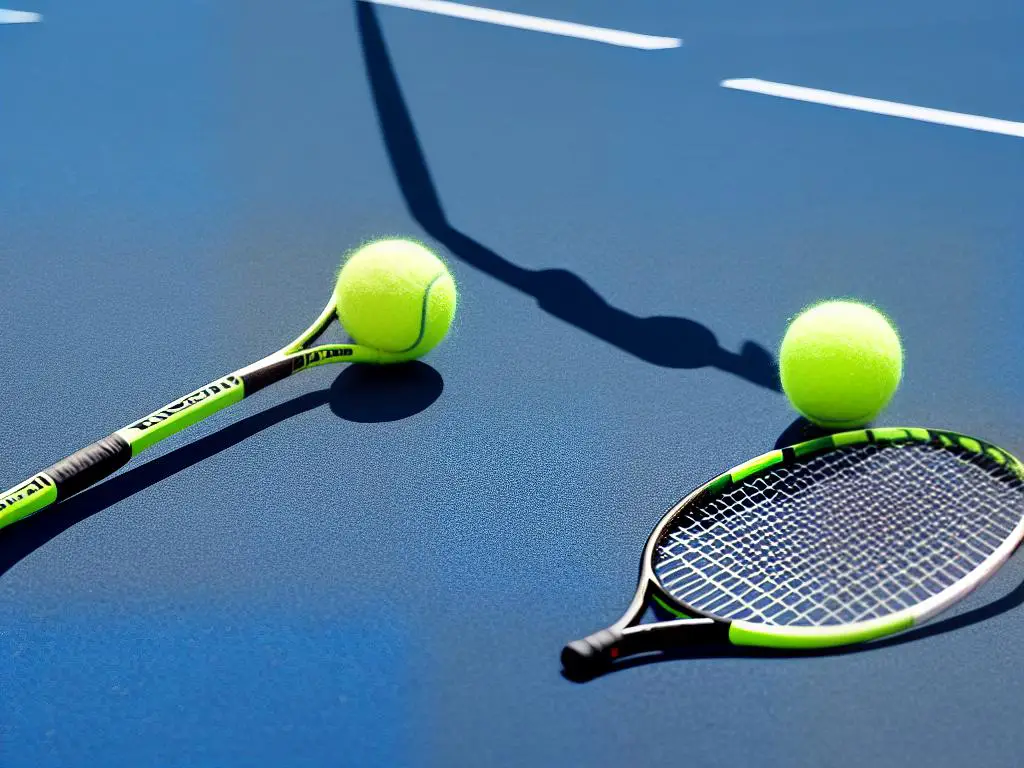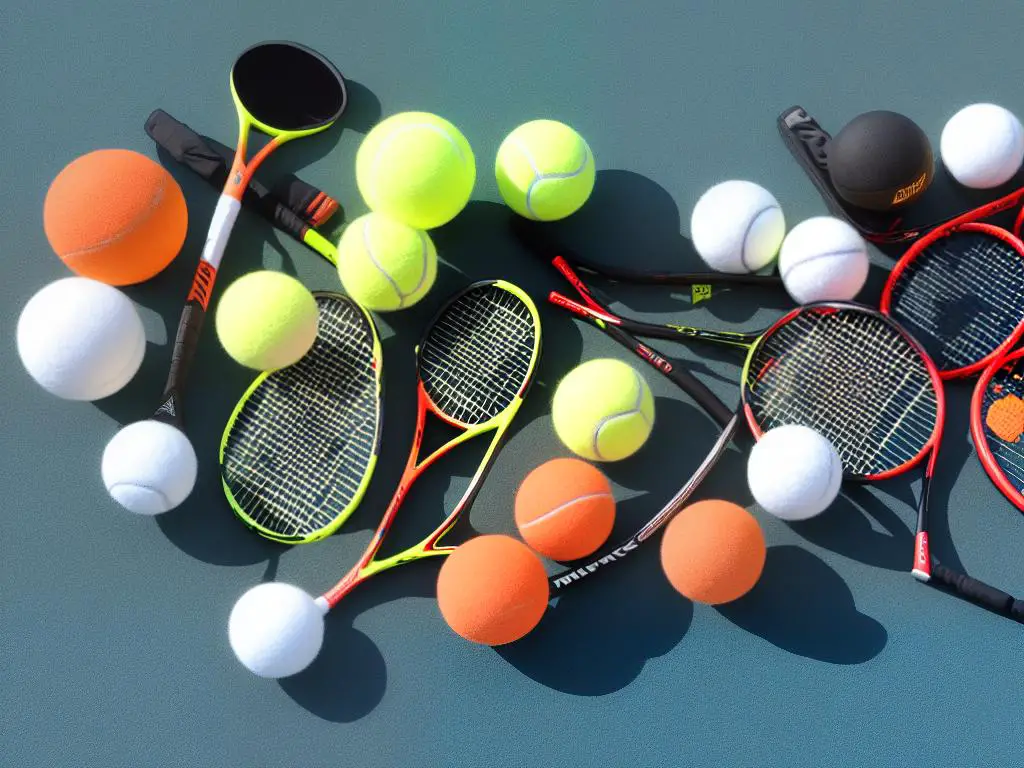As a sport steeped in history, tennis has seen a significant progression in its gameplay, owed notably to the evolution of its key equipment. The dynamic advances in technology and innovation have not only refined the design and utility of tennis gear but have also propounded the sportsmanship displayed on the court. This discourse delves into the story of tennis equipment, dissecting the progression from simple wooden racquets to technologically advanced gear. Furthermore, it explores the indelible influence these changes have had on player performance and the broader ramifications on the game itself. Finally, a glimpse into the future of tennis gear is projected, offering insights on the anticipated trends and potential regulatory impacts.
History of Tennis Equipment
Early Tennis Equipment: Wooden Racquets and Hand-stitched Balls
The history of tennis equipment stretches back centuries, with the game’s origins dating to the 16th century. The early tennis racquets were made of wood, specifically ash, with strings made from sheep gut. The handles were quite long compared to today’s standards, and the head of the racquet was relatively small. The balls utilized in these early stages of tennis were hand-stitched and filled with various materials such as cork, cloth and leather. Players had to be incredibly skilled given the low bounce these balls offered.
Transition to Metal: Steel Racquets and Pressurized Balls
In the 1960s, tennis equipment began its first major transformation. Wilson Sporting Goods introduced the first steel racquet, known as the T-2000. Compared to their wooden predecessors, these racquets were lighter, sturdier, and offered a larger sweet spot, or ideal striking area.
In addition, the tennis ball also underwent a significant change. The introduction of the Yellow tennis ball in 1972 by the ITF (International Tennis Federation) changed the game’s dynamic. These balls were pressurized and gave a higher and consistent bounce when compared to their hand-stitched predecessors. The bright color made them easily visible, enhancing the overall tennis-watching and playing experience.
Modern Era: Graphite Racquets and Technological Advancements
The development of tennis equipment didn’t stop with steel racquets and pressurized balls. The 1980s saw tennis equipment take another jump in technology with the advent of graphite racquets. These racquets were even lighter, stronger and more flexible compared to their steel counterparts.
This period also witnessed the integrating of other materials like kevlar, titanium, and carbon fiber to further enhance performance qualities. With this revolution, players could generate more power and control in their shots without exerting too much physical strength.
The modern tennis ball also saw consistent improvements, with manufacturers taking further steps to ensure even more uniform bounce and improved aerodynamics.
Innovation in Tennis Equipment: Personalized and High-tech
Tennis equipment has continued its evolution into the 21st century by progressing towards personalization and high-tech enhancements. Modern racquets now come in various sizes, weights, and balances to cater to different player styles and preferences. Advanced computer software is utilized in the design process to optimize energy transfer, stability, and vibration dampening.
Tennis balls have also been improved with the usage of more durable felt and latex, ensuring they can withstand the higher-paced modern game. Today’s game has even seen the integration of smart technology, with sensors to monitor a player’s performance and provide valuable data-driven insights.
From the humble beginnings of wooden rackets, the development of tennis equipment has seen monumental advancements, reflecting the ongoing evolution and improvements in the realm of sports. With disruptive technology reshaping how we play and understand the game, every piece of tennis gear is being redefined.

Influence of Technology in Tennis Equipment Development
Technology’s Role in the Development of Tennis Equipment
Indeed, major strides in technology have played an instrumental role in shaping the trajectory of tennis equipment. These technological leaps have precipitated a seismic shift in the tennis world, reflecting in the design, performance, and manufacturing of tennis apparatus. Noteworthy enhancements include computer-aided design, the introduction of innovative materials in the construction of tennis gear, and continually advancing tennis ball technology.
Computer-Aided Designs (CAD) in Tennis Equipment Development
The inception of computer-aided designs(CAD) in tennis equipment development has significantly influenced how tennis gear is designed and manufactured. Aided by computer software, designers are now able to create more efficient and effective designs. These improved designs have greatly enhanced gear’s overall performance, from increasing speed to reducing injuries. For instance, the CAD technology enables designers to optimize the weight distribution and balance of tennis rackets, thus improving performance and reducing potential injuries.
Incorporation of new materials in tennis rackets
Technological innovations have also influenced the type of materials used in creating tennis accessories, primarily rackets. Traditional wooden rackets have been replaced by more advanced and efficient materials such as carbon fiber, graphite, and titanium.
- Carbon fiber is widely used due to its remarkable strength-to-weight ratio. It increases the racket’s rigidity, thereby improving shots’ power.
- Graphite, on the other hand, is lightweight and offers significant flexibility, making it easier to manage and play with.
- Titanium is another material was chosen for its lightweight nature but offers high strength and resistivity, ensuring that the rackets are long-lasting.
Improvements in Tennis Ball Design
Advancements in technology have not only improved the rackets but have also had a profound impact on the design and manufacture of tennis balls. Modern tennis balls are now designed to offer maximum bounce, spin, and speed.
Technological improvements in the manufacturing process have allowed for better quality control, ensuring that every ball produced meets the desired standards. A mixture of rubber and felt is primarily used in tennis ball manufacture. The felt surface enables the ball to have a better grip on the racket, increasing the opportunity to control spin and direction while the rubber core offers maximum bounce and speed.
To wrap up, the progression of technology has significantly influenced the growth and development of tennis equipment, paving the way for the sport’s advancement. By homing in on improved performance, prevention of injuries, and ensuring quality, technological improvements persist in molding the future of tennis equipment, assuring an even more exciting experience for fans of tennis.

Effects on Player Performance and Games
The Evolution of Tennis Equipment and Its Impact on Player Performance
Parallel to the development of tennis throughout the years, the equipment intrinsic to the sport has seen remarkable transformations as well. Shifting from wooden rackets commonplace in the 19th Century to the current graphite and carbon fiber rackets, these alterations have left profound impacts on player performance and the game’s overall landscape.
The game-altering introduction of larger racket heads and lighter materials has significantly reshaped competitive tennis. Players can now achieve higher speeds and sharper precision with their hits. The United States Tennis Association has recorded a substantial surge in serve speeds within the professional arena, attributed to these progressive equipment enhancements.
Furthermore, the transition from orthodox gut strings to manufactured materials like nylon and polyester has granted players enhanced control and spin on the ball. According to a study published in Sports Engineering, this modification has induced a significant shift in the game dynamics, facilitating players to execute more aggressive, high topspin shots.
Equipment Influence on Injury Prevalence and Prevention
Changes in tennis equipment have not only impacted the way the game is played but also had significant implications for player health and injury prevention. Many equipment manufacturers have placed a precise focus on designing rackets, shoes, and other gear to minimize the risk of injury.
Over the years, racket weight and balance have been tweaked to reduce the stress on players’ shoulders and elbows. Lighter rackets with larger sweet spots result in less arm strain and a lower incidence of injuries such as tennis elbow. A study published in The British Journal of Sports Medicine reported a decline in incidence of tennis elbow with the advent of these modern rackets.
Footwear has also evolved, with shoes now crafted with advanced materials to offer better cushioning, stability, and support, which is critical in a sport that requires rapid multi-directional movements. This has reduced foot and ankle injuries and improved on-court performance.
However, while the evolution in tennis equipment has benefited player performance and injury prevention, some critics argue that it has negatively impacted certain aspects of the game. They argue that power and speed now often overshadow skill and tactics. This has sparked ongoing debate within the tennis community about equipment regulations and modifications to level the playing field.
Summarizing Tennis Equipment Development
Player performance, injury prevention, and game strategies in tennis have seen significant improvements due to the continuous advancements in equipment development. This ongoing progress in design and technology is continually setting new standards in the game of tennis.

Future Trends in Tennis Equipment
Looking Ahead: The Future of Tennis Equipment
The evolution of technology has a profound impact on many areas, including sports. Tennis is one of them, with its equipment witnessing substantial advancements enriching both player performance and comfort levels. The prediction for future trends in tennis equipment development includes personalization of racquets, integration of smart tech, and potential modifications in equipment guidelines.
The Rise of Personalized Racquets
Individuality has always been a significant part of tennis, with every player having a unique playing style, strength, and skill set. The future promises the development of even more personalized racquets to cater to these unique requirements.
Racquet personalization, which is already prevalent to an extent, might take a leap forward with more advanced customization techniques. For example, aspects such as racquet weight, balance, string tension, and grip size could be adjusted to more exact specifications based on each player’s preferences and playing style.
3D printing of tennis racquets could also potentially revolutionize the sport, enabling the production of racquets that are perfectly tailored to individual needs. This would allow players to have complete control over their equipment, leading to enhanced performance on the tennis court.
Smart Tech Applications in Tennis
Smart technology, once a luxury, is now making its way into everyday objects, and tennis equipment is no exception. The incorporation of smart tech in tennis racquets provides players with real-time data about their performance, helping them spot weaknesses and improve their swings, serves, and overall game strategy.
In the future, we may see a wider adoption of sensor technology in tennis equipment. Sensors integrated into racquets could track and analyze various parameters such as shot type, swing speed, and ball spin, providing valuable insights to players and coaches.
Additionally, virtual reality technology could also infiltrate tennis training. With VR, tennis players could practice against simulated opponents, enabling them to sharpen their skills in a controlled environment.
Potential Changes in Equipment Regulations
As innovation makes its way into the world of tennis, it may prompt some changes in the regulations regarding equipment. The International Tennis Federation (ITF), which oversees equipment standards, could implement new rules to balance the benefits of advanced technology with the integrity and fairness of the sport.
For example, as sensor-fixed racquets become more common, the ITF might need to define regulations regarding what kind of data can be collected and how it can be used during matches. Similarly, with the advent of 3D printed racquets, new guidelines might be introduced to regulate their usage in professional tournaments.
In conclusion
the future of tennis equipment looks promising, with personalized racquets, intelligent technology, and regulatory change on the horizon. As we move forward, these developments are expected to augment the sport, making it a more exciting, high-tech, and individualized experience.

Indisputably, it is innovation and technology that have fueled the transformation of tennis equipment, positively affecting the caliber of the game and enriching its spectator value. The incessant pursuit of improvement has not only reduced the risk of injuries for players but has also offered a more individualized approach to equipment. Towards the future, this trajectory of ingenious advancement is poised to continue with even more promising trends, possibly charting an exciting, unprecedented course for tennis as we know it. As enthusiasts, players, or casual observers of the game, understanding and appreciating this progress is essential to fully absorbing the essence of this captivating sport.